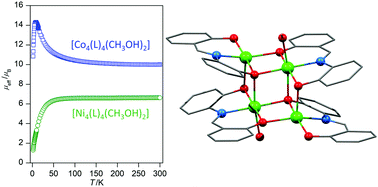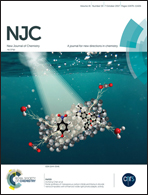Tetranuclear Ni(ii) and Co(ii) Schiff-base complexes with an M4O6 defective dicubane-like core: zero-field SMM behavior in the cobalt analogue†
Abstract
Two isostructural tetranuclear M(II)4 complexes with the general formula [M4(L)4(CH3OH)2] were prepared by the reaction of M(CH3COO)2·4H2O and H2L in the presence of Pr3N (M = Ni in 1, Co in 2, H2L = 2-{(E)-[(2-hydroxyphenyl)imino]methyl}phenol, Pr3N = tripropylamine). The crystal structure of 1 was determined by single-crystal X-ray diffraction and it was revealed that it possesses the defective dicubane {Ni4O6}2− core with two penta- and two hexacoordinate Ni atoms. The isostructurality of both complexes was confirmed by powder X-ray diffraction measurements. The analysis of the static magnetic data revealed that the prevailing antiferromagnetic interaction leads to the diamagnetic ground state in 1, whereas the ferromagnetic interactions dominate in 2. The analysis of magnetic data was supported by broken-symmetry DFT and CASSCF/NEVPT2 calculations, where the latter disclosed large magnetic anisotropy in both compounds. Moreover, the measurements of ac susceptibility in the zero-applied magnetic field confirmed the presence of slow-relaxation of magnetization in 2 and thus, this compound behaves as a single-molecule magnet.



 Please wait while we load your content...
Please wait while we load your content...